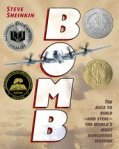 Bomb: The Race to Build –and Steal– the World’s Most Dangerous Weapon by Steve Sheinkin. Roaring Brook Press, Flash Point, 2012. 272 pages. Publisher recommends for ages 10 and up. ISBN: 9781596434875
Bomb: The Race to Build –and Steal– the World’s Most Dangerous Weapon by Steve Sheinkin. Roaring Brook Press, Flash Point, 2012. 272 pages. Publisher recommends for ages 10 and up. ISBN: 9781596434875
Newbery Honor Book in 2012;
Seibert Medal for Best Informational Book in 2012;
National Book Award Finalist 2012.
Bomb is a fast-paced nonfiction thriller that weaves together three stories all of which have an intense sense of urgency. The first is the construction of the atomic bomb in the United States, centered primarily in Los Alamos, New Mexico. The second is the attempt to deprive Germany of “heavy water” which they produced in a facility in Norway. Without heavy water, Germany’s atomic bomb development process would be slowed. The third is the attempt by the KGB to obtain information about the US atomic bomb so that the Soviets can build one more quickly than they would otherwise be able to.
Bomb includes many political decisions and political themes. The decision to start a bomb program in the US was a political decision made by President Franklin Delano Roosevelt. Three people, one British citizen and two US citizens, made a political decision to send secret documents about the bomb to the Soviets. The decision to use the bomb against Japan was a political decision made by President Harry S. Truman. The book also highlights the politics between the US and the Soviets in World War II and the beginning of the Cold War.
Bomb touches on the ethical/moral dilemma presented by a weapon of such destructive power. For me this is summed up best by Oppenheimer’s musings on the Bhagavad-Gita shortly after witnessing the test of the first atomic bomb: “Now I am become death, the destroyer of worlds.”
The people in the story are portrayed as humans, not as stick figures in a textbook. Sheinkin uses short quotes and snippets of dialog to help achieve this effect. He also uses observations about the characters. As the sense of urgency in Los Alamos grows stronger, Sheinkin notes that Oppenheimer, thin to begin with, is losing weight continually, and smoking 4 to 6 packs of cigarettes a day.
The science involved in building the bomb has always seemed more complicated to me then I could grasp. Sheinkin is able to make the science quite understandable.
Sheinkin closes the book with “But it’s also the story of how humans created a weapon capable of wiping our species off the planet. It’s a story with no end in sight. And, like it or not, you’re in it.” This quote reminds me that the fear I grew up with during the Cold War didn’t end when the Cold War ended, and that no matter how fascinating Bomb is, it tells the story of the building of a weapon terrifying beyond all imagining.
Other Blog Reviews:
Children’s Book-A-Day Almanac; Educating Alice; Heavy Medal; Someday My Printz Will Come; Instantly Interruptible

Reblogged this on kjmhoffman.
Thanks for the film recommendation on my blog, Liz. I will check to see if my local library has it. You were wondering if there was another book that might pair well with _Bomb_. Check out _Trinity_ by Jonathan Fetter-Vorm (2012). It’s short graphic history of the making of the bomb, but I’m pretty sure it’s for adults. Because it’s so visual, it would be great for high schoolers. It’s wonderfully complex in its presentation of the geopolitical and moral issues surrounding the bomb. If you read it, let me know what you think!
There is also a literature unit based on this book for teachers. It is geared toward high school English or social studies classes and is based on Common Core standards. It can be found at Curriculum Aids or on Amazon.
Thanks so much for this information!